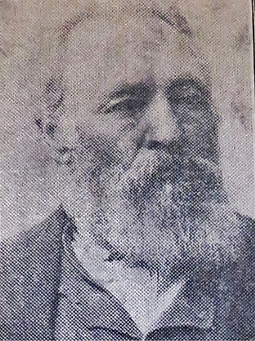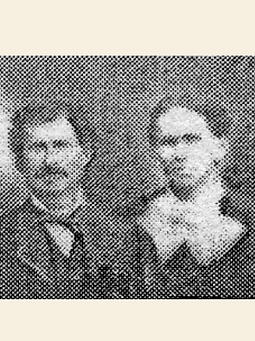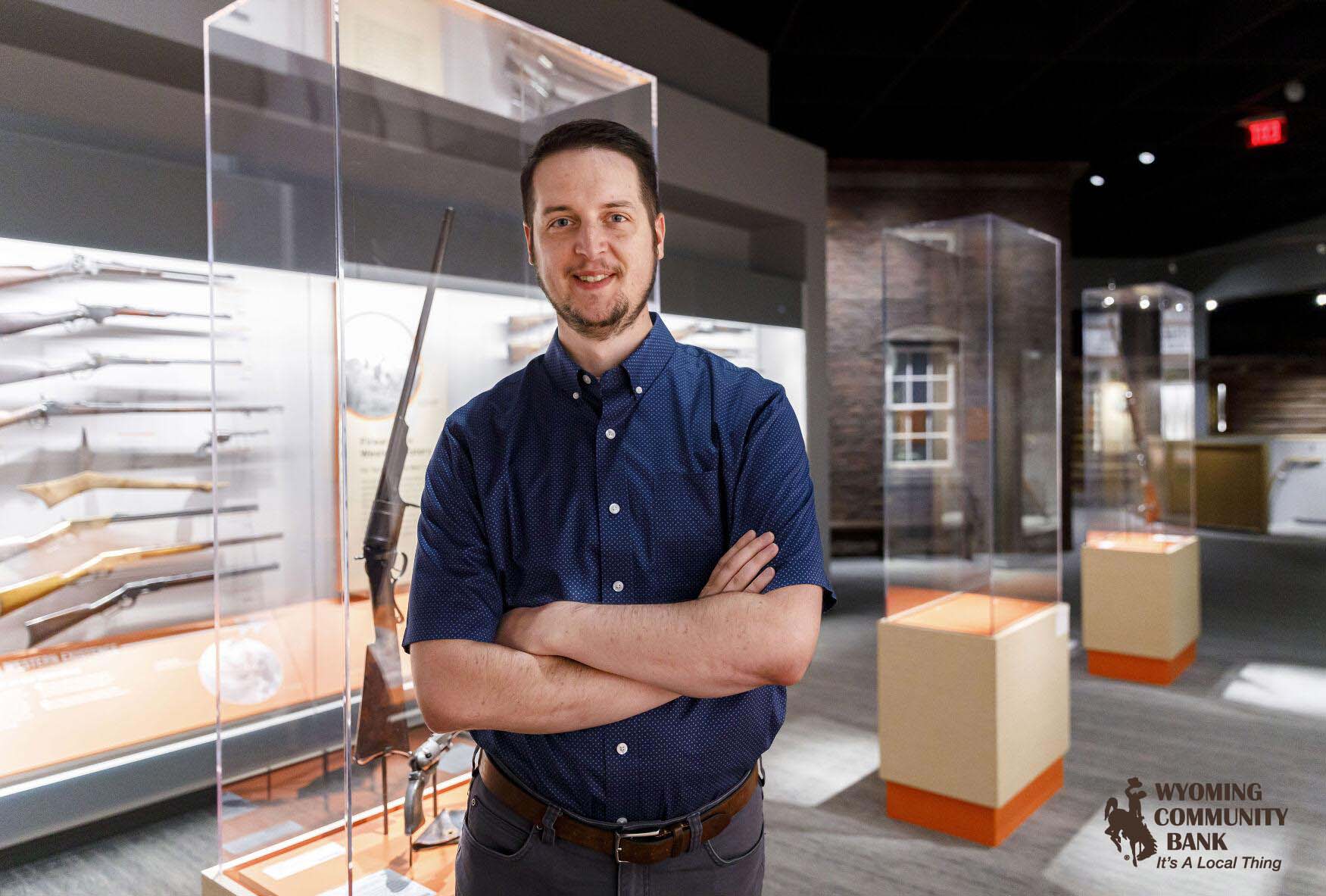Homesteaders T-Z
1880-1899
| TRIMBLE CLIFTON P. "TIP" b. ca. 1857 d. 1895 Year Arrived: Not Available Patent Year: 1886 Rng & Twn: 34N 98W Sections: 28 Acres: SCL-70 Map # 11 | See Other Entry |  |
| TRIMBLE CLIFTON P. "TIP" Year Arrived: Not Available Patent Year: 1887 Rng & Twn: 33N 99W Sections: 9 Acres: HE-156 Map # 8 | Clifton "Tip" Trimble was born in Kentucky about 1857 to unknown parents. In 1869 he located in the South Pass mining district and began freighting goods and merchandise from the railroad some 90 miles away. He was one of the earliest homesteaders in Lander Valley, arriving there in 1873 and taking up a homestead of 156 acres. His water claim filing in 1874 with neighbor John Knott is the earliest for which there is a record. They developed their properties before an official survey and together they claimed the entire waters of Baldwin Creek conducting it in a ditch to 160 acres of property for agricultural purposes. Tip and Charles Fogg were neighbors and when Charles' wife, Emma Virginia Wood, divorced him. She married Tip on August 6, 1890. Later, Tip and Emma also divorced. In 1886 he obtained a Sale Coal Land patent for 69.6 acres and opened the first coal mine in the Lander Valley in 1886. Later that year Trimble sold the mine to neighboring miners Peter McGinnis, John Gillis, and Charles Edwards of Edwards & Tappan Co. The 1891 tract records showed that Trimble sold his homestead on North Fork and the Charlie Edwards place on the Little Popo Agie to a prominent South Pass miner and resident of Lander, Louis Poire. After a long illness, Clifton Trimble died in Lander on February 12, 1895 at the age of 63. He is buried on his parent's farm in Kentucky. |  |
| TROSPER WILLIAM B b. 1840 d. 1915 Year Arrived: 1869 Patent Year: 1888 Rng & Twn: 32N 99W Sections: 2, 11 Acres: HE-160 Map # 5 | William Trosper was born April 3,1840, in Joplin, Missouri, to John and Anne Woolsey Trosper. William married Annie Evans (born in England) when he was 23. They were in the Utah Territory near Salt Lake City when their first five children were born. From 1874 through 1879 they were in Unita County, Wyoming Territory, where three more children were born. In 1879 William moved the family to a homestead on the Little Popo Agie of Lander where two more children were born. William died on October 15, 1915, in Lander. |  |
| TWEED EDWARD W. b. 1846 d. 1922 Year Arrived: 1872 Patent Year: 1892 Rng & Twn: 33N 99W Sections: 6 Acres: HE-160 Map # 8 | In 1879 Edward and his wife landed at William ("Boss") Tweed's ranch in Red Canyon and Edward began to work for his brother at the rate of $40 per month. William and his wife, Sarah Ann, had landed in America almost penniless. Edward must have felt constrained to move on and make his own way after only four months of work for his brother. That he was successful was attested by the fact that he and his wife were building a fine new home just seven years later, on what is now known as Tweed Lane. They had a thriving irrigated farm just north of Lander and were prosperous enough to visit their old home in England in 1898. Edward Tweed died in Lander on October 15, 1915 and is buried at Mount Hope Cemetery. |  |
| TWEED GEORGE H b. 1855 d. 1925 Year Arrived: Not Available Patent Year: 1899 Rng & Twn: 30N 98W Sections: 18 Acres: HE-160 Map # 1 | George Tweed was born on March 11, 1855, the youngest of five boys in a family of 19, at Yorkshire, England. He came to Wyoming with his wife Barbara Crowther in August 1888, and spent their first year with his older brother, William, in Red Canyon. He homesteaded on Tweed Creek, a tributary of Twin Creek, and ranched there for several years. He then moved to the North Fork where he lived for about ten years. He was living in his home in Lander when he passed away in 1925. | |
| TWEED SARAH b. 1836 d. 1911 Year Arrived: Not Available Patent Year: 1894 Rng & Twn: 33N 99W Sections: 6 Acres: SCE-40 Map # 8 | Sarah Pearson was born in Liverpool, Lancashire, England on March 11, 1836, daughter of Peter Pearson, a carpenter. She married William Tweed on July 19, 1858. In 1859 or 1860 they immigrated to America settling in Canton, Missouri where in 1860 Edward worked in various sawmills. They had nine children, William Pearson who died at age 11, newborn infant who died in infancy, David, Thomas who died at age five, Sarah, Benjamin, Samuel who died in infancy, Elizabeth, and Charlotte. Four children lived to adulthood. By 1870 the family had moved to South Pass City where Sarah is listed as the first white woman to live in the South Pass mining district. In the 1880 census she is listed in Red Canyon, Sweetwater County, Wyoming, where she is said to be keeping house. She obtained a homestead patent in 1894. William "Boss" Tweed, her husband, died in 1907. In the 1910 census she is living with her son, David. She died on September 11, 1919 in Lander. She is buried in the Mount Hope Cemetery next to her husband. |  |
| TWEED WILLIAM b. ca. 1834 d. 1907 Year Arrived: 1867 Patent Year: 1891 Rng & Twn: 31N 99W Sections: 22, 23, 26, 35 Acres: SCE-640 Map # 4 | William "Boss" Tweed was born in England in 1834 or 1835 and came to the United States in 1859 or 1960. He became a naturalized citizen in 1878. William returned to England to marry his wife, Sarah Ann Pearson. After spending time in South Pass City, he homesteaded in Red Canyon and raised beef. Tweed died at his home in Red Canyon on January 17, 1907, and is buried in the Odd Fellows section of Mount Hope Cemetery in Lander. (see story) |  |
| VETTER AARON b. 1854 d. 1943 Year Arrived: Not Available Patent Year: 1894 Rng & Twn: 34N 100W Sections: 33 Acres: HE-120 Map # 13 | Aaron Vetter was born January 22, 1854 in Virginia to George Wilhelm Vetter and his second wife, Mary Catherine Doll. Aaron's half-sister, Anna Elizabeth, left their Virginia home and married Frederick H. Leseberg of Missouri. Aaron married Ann Baldwin in Virginia and when the Lesebergs settled in the Lander Valley, Aaron, his wife, and his brother, Phillip Henry, joined them on the North Fork of the Popo Agie River. Aaron homesteaded 120 acres near the Lesebergs; he also homesteaded 40 acres next to the 160-acre homestead of his bachelor brother, Philip. Aaron returned to his home in Shenandoah County, Virginia, and died there June 29, 1943. | |
| WAGNER JOSEPH Year Arrived: 1869 Patent Year: 1894 Rng & Twn: 31N 99W Sections: 9, 10 Acres: HE-160 Map # 4 | See Other Entry | |
| WAGNER JOSEPH b. 1845 d. 1915 Year Arrived: 1868 Patent Year: 1893 Rng & Twn: 31N 99W Sections: 10 Acres: SCE-40 Map # 4 | Joseph Wagner was born in Ohio on November 11, 1845, raised in Indiana, and at the breaking out of the Civil War was in the South and became a wagon master in the army of the Confederacy. He, like many others who had served on the side of the South, came west in 1866 and soon located in Wyoming. He worked as a miner for several different parties and in 1870 was a foreman at the newly developed Carissa Mine. In 1871, he took the contract to develop the English Tunnel on the Wild Irishman Mine. In 1873 he bought the Pacific Springs Ranch and four years later went to Red Canyon, where he resided on a homestead for 18 years. Joe married Sarah Ellen "Dolly" Tweed on June 30, 1882, and four daughters were born to them. By 1900, the family had moved to the Lander area where Joseph continued farming on North Fork. He died at the home of his son-in-law on March 2, 1915, in Lander. | |
| WEISBROD JOHN M. b. 1856 d. 1935 Year Arrived: Not Available Patent Year: 1893 Rng & Twn: 31N 99W Sections: 9 Acres: HE-160 Map # 4 | Wilhelm Schneider was born in 1852. He and John Kimpel, friends and both of German descent, filed on adjacent homesteads on the North Fork of the Popo Agie near the small settlement of Milford in 1889. Where their property lines adjoined each other, they built a single large house constructed of locally quarried sandstone. In addition, to farming they formed a joint investment company, of Kimpel, Nikolas, and Schneider. Kimple had business interests in Virginia which he attended during the winters. Neither Wilhelm Schneider nor John Kimpel married and when Wilhelm fell ill and died in late 1899, partner John Niklos bought the house. John Kimpel, after settlement of the estate, moved back to Virginia. Wilhelm died in December of 1899 and is buried in the Masonic Cemetery near Milford, Wyoming. John Weisbrod was born in May 1856 at Meinigen Saxony, Germany, to unknown parents. He married Elizabeth Tweed of Red Canyon on November 24, 1886. According to his brother-in-law, Dave Tweed, Mr. Weisbrod bought his first farm that same year from a Mr. Barrett, a squatter who had been farming on the property since 1869 and who was the first to till the fertile soil of Red Canyon. Barrett raised vegetables for sale at the South Pass gold mines and preceded William Tweed, Joseph Faris, and Edward Young as possibly the first commercial farmer in the Lander Valley, In 1893 Mr. Weisbrod received a patent for his property. He and his wife raised three daughters and five sons while in Wyoming and had a sixth son after they moved to California in 1909. Elizabeth died there in 1935 and John died in San Diego, California, on December 2, 1935, at age 80. | |
| WELLER DANIEL b. 1853 d. 1936 Year Arrived: Not Available Patent Year: 1891 Rng & Twn: 34N 100W Sections: 29 Acres: HE-188 Map # 13 | Daniel Weller was born in December 1853 in Michigan. He married Mary Lucinda Trenholm, age 16, of North Fork on June 6, 1882. He homesteaded 188 acres on the North Fork of the Popo Agie River. He and Mary moved to Meeteetse, Wyoming. In the 1900 census his occupation was listed as livery man. There were two young Weller children listed in the census. Daniel died in Meeteetse in 1936 and is buried in the Meeteetse Cemetery. | |
| WERLEN JOHN b. 1844 d. 1910 Year Arrived: 1873 Patent Year: 1890 Rng & Twn: 31N 99W Sections: 24 Acres: HE-160 Map # 4 | John Werlen was born on September 27, 1844, being the fourth of a family of eight children. He grew up in Illinois and learned the trade of harness maker. He entered the Civil War and followed his trade during the four years of that war. In 1868 he went to the placer mines of Montana and engaged in mining and freighting. In 1875 he came to the Lander Valley and continued freighting and also and homesteaded a ranch in 1877. Miss Josephine Ackerman became his wife on September 23, 1877. Four daughters graced this union: Josephine Mary, Louise, Helen, and Florence. John was was a director of the First National Bank and Central Trust, Company, and was long engaged in the sheep and cattle business. Mrs. Werlen died died December 13, 1887 and Mr. Werlen survived until 1910 after being ill for two weeks. They are buried at Mt. Hope Cemetery in Lander. |  |
| WILSON ASIL T. b. 1845 d. 1924 Year Arrived: 1879 Patent Year: 1892 Rng & Twn: 34N 100W Sections: 35 Acres: HE-159 Map # 13 | Asil "Ase" Wilson was born in Jerusalem, New York on October 12, 1845. He was the seventh of eleven children. At the age of 16 years he volunteered to serve in the Union Army serving as bugler in After the war, Asil returned to New York, where he farmed and owned a sawmill. He married Eliza Cobb on September 17, 1871. In 1872, the Wilson family moved westward, first living at Fort Laramie where Asil built and operated a sawmill for the military. As successive forts were established, he moved with them; these included Camp Stambaugh, Camp Brown (which later became Lander) and Fort Washakie on the Shoshone Indian reservation. At the latter Mr. Wilson made adobes and helped build soldiers quarters. Spurred on by the demands and consumption of newly established Fremont country, Wilson built a grist mill near his homestead on North Fork in 1880 and then a sawmill on Big Popo Agie River in 1883. In the meantime, he built his family a beautiful twelve-room house near the flour mill at Milford, four miles from Lander. Their home was the center of all the social activities of the early days. Ase had the mining fever that persisted near the Atlantic City mining section even after its abandonment. He filed placer claims and spent his summers there seeking gold that might have been overlooked in earlier days. To assist his mining efforts he built a ditch, thirteen miles long, on Twin Creek. All the net receipts of his flour mill went into ditch construction before it was completed in 1906. Asil Wilson died in 1924 and is buried in the Masonic Cemetery near Lander |  |
| WISSER PHILLIP b. 1835 d. 1903 Year Arrived: 1870 Patent Year: 1891 Rng & Twn: 31N 98W Sections: 18 Acres: HE-169 Map # 3 | Philip Wisser was born in Bavaria (Prussia), Germany, in January 1835. In 1853 he came to America as a young boy seeking a new life as he was deprived of his inheritance following the death of his parents. He was a bullwhacker (teamster) in Montana where he met fellow countryman Joseph Himmelsbach. Together in 1869 they came to the Lander Valley where both took up homesteads. Wisser's homestead was located on Weiser Creek, a tributary to Cottonwood Creek, the area visible today below Highway 28 about 12 miles south of Lander. Philip was quiet and reserved, making only a few friends to whom he was unwaveringly loyal. He remained single, raising livestock and through which he accrued a considerable estate up to the time of his death on June 17, 1903. His loyalty to Fremont County was recounted in his obituary which read, "the deceased has bequeathed his entire estate consisting of about 6,500 head of sheep, 150 cattle, and 60 horses, the Cottonwood Ranch, and highly valued patented land to the Agricultural College at Lander." His Lander property, formerly the George Wroe Ranch, became the site of Fremont County Vocational High School, and is today the site of the Museum of the American West and Fremont County Pioneer Museum. | |
| WROE GEORGE NEFF b. 1840 d. 1916 Year Arrived: 1868 Patent Year: 1893 Rng & Twn: 33N 100W Sections: 12 Acres: HE-160 Map # 9 | George Wroe was born on February 25, 1840, in Fayette County, Pennsylvania. He joined the movement west and on January 10, 1875, married Alice Jane Davis in the hotel at South Pass City. At this time Mr. Wroe was a teamster living at Anthony's Saw Mill, Sweetwater County. After living there one year, Mr. and Mrs. Wroe moved to the Lander Valley. He became a farmer and much enjoyed that occupation. Mr. and Mrs. Wroe had nine children, many of whom remained in the Valley. He died suddenly at his ranch on November 13, 1916. He is buried at Mount Hope Cemetery in Lander. | |
| WYGALL WILLIAM b. 1857 d. 1929 Year Arrived: Not Available Patent Year: 1890 Rng & Twn: 34N 99W Sections: 31 Acres: SCE-80 Map # 12 | William Wygal was born March 27, 1857, in Missouri to unknown parents. He married Sarah Susan Stephenson in Lewis County, Missouri, on December 17, 1877. They moved to Weld County, Colorado (1880 census), to a farm where their son, Wayne Lee Wygal, was born February 12, 1882. They returned to Sarah's parent's home in Canton, Lewis County, Missouri, where their second child, Mary Elizabeth, was born on June 7, 1884. Leaving his family in Missouri, William came to the Lander Valley in the fall of 1885 where he homesteaded 80 acres on the North Fork of the Popo Agie. He had the house fully built and plastered by the time his family joined him in October 1888. He received the patent for his homestead property in 1893 and immediately sold it to F. E. Rice. He then moved to Lander and entered a construction business in the same year. The 1900 census for South Pass City listed William with his family, employed in the construction and freighting business. The family was in Glendale, Colorado, in the 1910 census, and made a final move to Idaho. William died there April 11, 1929 and Sarah died in Filer, Idaho, on May 14, 1953, at the home of her daughter Mary Elizabeth. | |
| YOUNG EDWARD b. 1844 d. 1930 Year Arrived: 1869 Patent Year: 1890 Rng & Twn: 31N 99W Sections: 9 Acres: SCE-80 Map # 4 | Edward ("Ed") Young was born August 12, 1844, in Bremen, Germany, to unknown parents. He immigrated to the United States with a cousin in 1863, first locating in New York State and then going, in 1866, to Omaha Nebraska where they enlisted as soldiers to guard the men who were building the Union Pacific's part of the Transcontinental Railroad. Following the union of the Central and Union Pacific tracks at Promontory Point in Utah, Ed was discharged. He then engaged in mining operations at South Pass where he continued to live until 1870. It was then that he took up the life of a stockman turned farmer-rancher on the Little Popo Agie River in Red Canyon. Ed took up several homesteads through the years to accommodate stock raising, gardener activities and ultimately the occupation in which he was to build the acclaimed reputation as Wyoming's first commercial fruit grower. He marketed his first crop of apples in 1888 in the thriving city of Lander and quickly became the possessor of the finest apple orchard in the state, took countless prizes in county and state fairs, and most notably received a silver medal for his apples at the 1904 St. Louis World Fair. Ed was afforded the well-deserved title of "Apple King of Lander Valley." He remained single most of his life, but at age 71 he married an abandoned woman, Mrs. Virginia Weed, in 1915 Mrs. Weed was over 30 years his junior and had a young child, Erma Grena. The added stress of this marriage and attendant financial burden caused Ed's health and wealth to decline to the point where he was forced to sell his beautiful ranch to pay off a heavy mortgage. The marriage ended in divorce. Following several accidents and illness while living in Lander, Edward Young died on April 16, 1930, at the age of 86. |  |
| YOUNG EDWARD Year Arrived: 1869 Patent Year: 1893 Rng & Twn: 31N 99W Sections: 4, 9 Acres: HE-160 Map # 4 | See Above | |
| YOUNG EDWARD Year Arrived: 1869 Patent Year: 1895 Rng & Twn: 31N 99W Sections: 4 Acres: SCE-160 Map # 4 | See Above | |
| YOUNG EDWARD Year Arrived: 1869 Patent Year: 1895 Rng & Twn: 33N 99W Sections: 13, 18 Acres: SCE-159 Map # 8 | See Above |

How You Can Help
Ways To Give
Annual Giving
Annual gifts of any size are always welcome. Learn more today about how you can give to any of our locations on an annual basis.
Planned Giving
Making a planned gift is quite simple. Learn more today about how you can plan your gift to any of the Fremont County Museums.
Make a Donation
Simply make a one time donation to your Museum of choice. Every bit helps!











